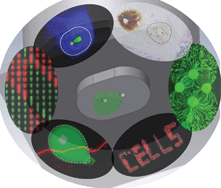Microfluidic probes for use in life sciences and medicine
Abstract
Microfluidic probes (MFPs) combine the concepts of microfluidics and of scanning probes and constitute a contact-free and channel-free microfluidic system. Whereas classically the sample is introduced into the microfluidic device, with a MFP, the microfluidic stream is applied to the sample. MFPs use hydrodynamic flow confinement instead of walls to constrain a microfluidic stream between the MFP tip and a substrate. Because MFPs are free to move, they can be used to process large areas and samples in a selective manner. The development of MFP technology is recent and has numerous potential applications in several fields, most notably in the life sciences. In this review, we discuss the concept of MFPs and highlight their application in surface biopatterning, controlling the cellular microenvironments, local processing of tissue slices, and generating concentration gradients of biochemicals. We hope that this manuscript will serve as an interdisciplinary guide for both engineers as they further develop novel MFPs and applications and for life scientists who may identify novel uses of the MFP for their research.


 Please wait while we load your content...
Please wait while we load your content...